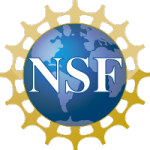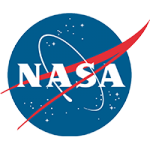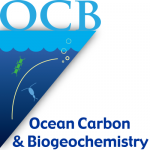The 2016 OCB Summer Science Workshop was held July 25-28, 2016 at the Woods Hole Oceanographic Institution in Woods Hole, Massachusetts. View the social media activity for this meeting at #OCB2016!
1. Plenary Sessions
Monday, July 25, 2016
EXport Processes in the Ocean from RemoTe Sensing (EXPORTS)
EXPORTS is a scoping study for a major NASA field campaign to quantify the state of the ocean biological pump from satellite observations. This session included a brief overview of the EXPORTS science plan and its role in NASA planning, followed by a series of talks that highlight the three overarching science questions in the plan. Currently, a science definition team is developing a detailed implementation plan for the EXPORTS field campaign. Following the science presentations, a brief overview of the draft EXPORTS implementation plan was presented, with plenty of time thereafter for discussion.
The Biology of Carbon Export: New Processes and Approaches
NSF recently sponsored a workshop to foster discussions around new perspectives and identify critical gaps in our understanding of key biological processes involved in ocean carbon export. This session included a brief overview of the workshop, its outcomes, and its role in NSF planning (see white paper entitled Towards a transformative understanding of the ocean’s biological pump: Priorities for future research, followed by a short series of science talks highlighting some of the biologically mediated processes that emerged from workshop discussions.
Tuesday, July 26, 2016
Recent Advances in Quantifying Ocean Carbon Uptake
This session highlighted exciting new research developments on ocean carbon uptake across spatial (coastal to open ocean) and temporal (paleoclimate to future climate scenarios) scales. Plenary speakers addressed advances in observation and modeling, including new approaches to estimating interannual variability in CO2 uptake using interpolated data, as well as new ensemble modeling approaches that estimate the time of emergence in ocean carbon uptake trends against the backdrop of natural variability.
Southern Ocean Carbon and Climate Observations and Modeling (SOCCOM): A Prototype for a Global Biogeochemical-Argo Array
SOCCOM has ~50 profiling floats with oxygen, pH, nitrate, and bio-optical sensors in all regions of the Southern Ocean from seasonal ice zones to the open ocean, and the array will grow to ~200 floats in several years. In this session, we’ll describe work in progress to analyze the annual cycles of carbon, oxygen, nitrate, and chlorophyll observed by the sensors and efforts to integrate the data with numerical models. Finally, we’ll report on work to develop the science and implementation plan for a global observing system based on profiling floats with biogeochemical sensors.
Wednesday, July 27, 2016
The Indian Ocean: Monsoon-Driven Biogeochemical Processes
The monsoonal forcing of the Indian Ocean makes it a unique oceanic basin that is subject to semi-annual reversals of its boundary currents, stark contrasts in buoyancy forcing between the Arabian Sea and Bay of Bengal, as well as semi-annual manifestation of the zonal, cross-basin equatorial Wyrtki Jets. Connectivity with the Pacific Ocean via the Indonesian Throughflow introduces further dynamical complexity to the Indian Ocean basin. In celebration of the 50th anniversary of the International Indian Ocean Expedition (IIOE) and launch of the IIOE-2, this plenary session focused on how these complex physical oceanographic and climatic drivers influence biogeochemistry and biological processes in this ocean basin.
Thursday, July 28, 2016
Marine Ecosystem Thresholds and Regime Shifts
Marine ecosystem regime shifts have been observed in many locations and periods around the global ocean, and more regime shifts may occur as key anthropogenic stressors change in the coming years to decades. However, the drivers of marine ecosystem regime shifts remain poorly understood, as are their consequences for biogeochemical cycles and the management of marine resources. In this session, we document key examples of marine ecosystem regime shifts and examine their likely causes, as well as discuss the impacts of regime shifts on biogeochemical cycles and the management of altered ecosystems.
ARCTIC-COLORS Workshop
Thursday, July 28-Friday, July 29 (Woods Hole Oceanographic Institution)
Organizers: Antonio Mannino (NASA GSFC), Maria Tzortziou (CUNY)
The panel convened by NASA OBB to review a preliminary version of the Arctic-COLORS Science Plan was very supportive of Arctic-COLORS and recommended revisions and re-submission of the report for further consideration by NASA. Immediately following the OCB workshop, there was a 1.5-day open community workshop at WHOI (July 28-29) to engage interested scientists in a dialog about the proposed field campaign and obtain broad community input on these revisions. During this workshop we (1) focused on the top level science questions, (2) discussed potential de-scoping scenarios, and (3) narrowed the study domain.
2. Agenda with Talks and Webcast Footage
Monday July 25, 2016
8:30 Welcome and introduction (Heather Benway, OCB/WHOI, Mark Abbott, WHOI) (Redfield) – webcast_Abbott, webcast_Benway
8:45 The PACE Mission: New capabilities on the horizon (Michael Behrenfeld, Oregon State Univ., Paula Bontempi, NASA HQ) – webcast
Plenary 1. EXport Processes in the Ocean from RemoTe Sensing (EXPORTS) (Redfield)
Chairs: David Siegel (Univ. California, Santa Barbara), Meg Estapa (Skidmore)
9:15 Introduction/overview of EXPORTS Science Plan in context of NASA mission (David Nicholson, WHOI) – webcast
9:30 Processes in euphotic zone (Mary Jane Perry, Univ. Maine) – webcast
9:50 Processes in twilight zone (Adrian Martin, National Oceanography Centre) – webcast
10:10 Predictability (Scott Doney, WHOI) – webcast
11:00 EXPORTS Implementation (Meg Estapa, Skidmore College) – webcast1, webcast2
11:30 Group discussion (Moderated by Bethany Jenkins, URI) – webcast
Plenary 2. The biology of carbon export – New processes and approaches (Redfield)
Chairs: Adrian Burd (Univ. Georgia), Uta Passow (Univ. California, Santa Barbara)
1:30 Introduction/overview of biopump workshop/activity in context of NSF objectives (Michael Sieracki, NSF) – webcast
1:45 Mixotrophic modulators of the biological pump (Holly Moeller, WHOI) – webcast
2:15 Marine microgels: Elucidating the DOM-POM continuum with gel theory (Monica Orellana, Institute for Systems Biology) – webcast
2:45 Constraining the full spatial and temporal scales of variability in the ocean’s biological carbon pump: From episodic events to global patterns (Andrew McDonnell, Univ. Alaska, Fairbanks) – webcast
3:15 Community-sharing presentation: Novel observations of carbon export from autonomous Lagrangian Carbon Flux Explorers (CFEs) (Jim Bishop, Univ. California, Berkeley) – webcast
4:00 Discussion/Q&A – webcast
4:30 Student presentations – webcast
Tuesday July 26, 2016
8:00 Agency updates and Q&A (NSF, NASA, NOAA) (Redfield) – webcast (Murray), webcast (Garrison), webcast (Bontempi), webcast (Tedesco)
Plenary 3. Recent advances in quantifying ocean carbon uptake (Redfield)
Chairs: Nicole Lovenduski (Univ. Colorado), Matthew Long (NCAR)
9:00 Observing variability in ocean CO2 fluxes (Peter Landschützer, Max Planck Institute for Meteorology) – webcast
9:30 Detection of change in ocean carbon uptake: Data and models (Galen McKinley, Univ. Wisconsin, Madison) – webcast
10:00 Physical processes and linkages to carbon uptake (Marina Lévy, LOCEAN-IPSL) – webcast
10:45 Carbon uptake and feedbacks in Coupled Model Intercomparison Project (CMIP) (Matthew Long, NCAR, presented by Scott Doney, WHOI) – webcast
11:15 Ocean carbon storage during the Last Glacial Maximum (LGM) (Bob Anderson, LDEO) – webcast
11:45 Carbon uptake and exchange at the land-ocean interface (Peter Raymond, Yale Univ.) – webcast
12:15 Community-sharing presentation: Carbon Hot Spot (Andrea Fassbender, NOAA/PMEL and Stuart Bishop, NCSU) – webcast
Plenary 4. Quantifying ocean carbon, oxygen, and nutrient cycles (Redfield)
Chairs: Ken Johnson (MBARI), Jorge Sarmiento (Princeton)
2:00 SOCCOM introduction and physical background (Lynne Talley, Scripps Inst. Oceanography) – webcast
2:20 Southern Ocean carbon from profiling floats equipped with pH (Nancy Williams, Oregon State Univ.) – webcast
2:40 A large wintertime Southern Ocean CO2 source detected by biogeochemical profiling floats (Jorge Sarmiento & Alison Gray, Princeton University) – webcast
3:00 Planning for a global Biogeochemical-Argo network (Ken Johnson, MBARI) – webcast
3:20 Discussion/Q&A – webcast
Broadening your impact: Interactive science communication session with COMPASS (Chairs: Bethany Jenkins (URI), Anton Post (URI))
- Redfield Auditorium: A hands-on interactive session focused on providing you with tools to communicate and engage more effectively with a broad range of audiences (Amy Matthews-Amos, COMPASS)
- WHOI Exhibit Center Auditorium: A hands-on or interactive session focused on using social media tools to network and share your science more broadly (Meg Gilley, COMPASS)
Wednesday July 27, 2016
The following sessions were not webcast and presentations are not available. However, there are links to related materials below.
Special Session. What was accomplished at COP21? An Insider Perspective (Redfield)
Chair: Scott Doney (WHOI)
10:15 Joint presentation (Heather Goldstone, Cape and Islands NPR; Judith Fenwick, WHOI) and discussion/Q&A – webcast
Plenary 5. The Indian Ocean – Monsoon-driven biogeochemical processes (Redfield)
Chairs: Jerry Wiggert (USM), Mike Lomas (Bigelow), Mike Landry (SIO), Raleigh Hood (UMCES)
11:15 Indian Ocean dynamics overview – Observing systems (Michael McPhaden, NOAA/PMEL) – webcast
11:45 Dissolved organic carbon (DOC) in the Indian Ocean (Dennis Hansell, RSMAS) – webcast
12:15 Implications of Indian Ocean GEOTRACES for basin-scale biogeochemistry (Jim Moffett, Univ. Southern California) – webcast
2:00 Iron limitation patterns, Indian Ocean Dipole (IOD) impacts, monsoon-climate connections (Jerry Wiggert, Univ. Southern Mississippi) – webcast
2:30 Oxygen deficiency in the water column of the North Indian Ocean (Wajih Naqvi, National Inst. Oceanography) – webcast
3:15 Biology and nitrogen fixation in the Leeuwin Current (Anya Waite, Alfred Wegener Inst.) – webcast
3:45 Biogeochemical and ecological impacts of boundary currents in the Indian Ocean (Raleigh Hood, UMCES) – webcast
4:15 Discussion and remaining questions – webcast
4:30 US SOLAS and OCB: Opportunities for collaboration (Plenary discussion led by Rachel Stanley, Wellesley College) – webcast
Thursday July 28, 2016
8:30 Presentation and community discussion session on proposed Arctic-COLORS field study (Antonio Mannino, NASA/GSFC, Maria Tzortziou, CCNY) – webcast
Arctic-COLORS Discussion (webcast)
Plenary 6. Marine ecosystem thresholds and regime shifts (Redfield)
Chairs: Jeremy Mathis (NOAA), Andrew Barton (NOAA GFDL/Princeton), Jasmin John (NOAA GFDL/Princeton)
9:30 Climate change, phytoplankton and regime shifts (Philip Boyd, Univ. Tasmania) – webcast
10:00 Climate change and trophic mismatches between plankton blooms and fish phenology (Rebecca Asch, Princeton Univ.) – webcast
10:45 The Pacific Arctic region: A window into shifting benthic populations in response to ecosystem change (Jacqueline Grebmeier, UMCES) – webcast
11:15 Identifying indicators of regime shifts (Mary Hunsicker, NOAA Northwest Fisheries Science Center) – webcast
11:45 Discussion and questions – webcast
12:00 GEOTRACES/OCB workshop (Bob Anderson, LDEO) – webcast
12:20 Closing remarks (Bethany Jenkins, Heather Benway) – webcast
Arctic-COLORS Workshop
- NASA OBB Program: Recommendations and Next Steps for Arctic COLORS (Paula Bontempi, NASA Headquarters) – webcast
- Arctic COLORS Scoping Study Report: Review Panel Comments and Recommendations (Maria Tzortziou, CCNY) – webcast
- Group discussion on Arctic COLORS revised science questions (Moderated by Paty Matrai, Bigelow) – webcast
- Rob Spencer talk – webcast
Friday July 29 (this session was not webcast)
8:30 Summary of Progress from Thursday afternoon (Marjy Friedrichs, VIMS)
8:45 Group discussion on Arctic COLORS revised science questions (Moderated by Antonio Mannino, NASA/GSFC)
10:30 Continue discussion on Arctic COLORS revised science questions (Moderated by Peter Hernes, UC Davis)
11:30 Discussion on optimizing, and if needed constraining the Arctic COLORS Study Domain (core and extended regions) (Moderated by Maria Tzortziou, CCNY)
12:00 Discussion on optimizing the Arctic COLORS Field Measurements Program (process studies and synoptic surveys) (Moderated by Antonio Mannino, NASA/GSFC)
1:30 Arctic COLORS Implementation Plan (Discussion moderated by Joe Salisbury, Univ. of New Hampshire)
2:00 Arctic-COLORS within the context of other U.S. agency programs and international initiatives (Discussion moderated by Paty Matrai, Bigelow)
- 2016 CCGS Amundsen Expedition Plan
- BaySys: Contributions of climate change and hydro-electric regulation to the variability and change of the freshwater-marine coupling in the Hudson Bay system (Marie-Hélène Forget, Université Laval)
- Green Edge 2016 (Eric Rehm, Takuvik, Université Laval, Quebec)
- TAKUVIK research activity- Tracing biogeochemical processes of changing Arctic Ocean (Atsushi Matsuoka, Takuvik Joint International Laboratory, CNRS, Université Laval)
2:30 Next Steps (Marjy Friedrichs, VIMS)
Relevant Information
- Biological Pump white paper Towards a transformative understanding of the ocean’s
biological pump: Priorities for future research (open for comment until Aug. 1, 2016)
- EXPORTS Science Plan
- EXPORTS Draft Implementation Plan (open for comment until Sept. 1, 2016)
- Arctic-COLORS Science Plan
- NASA Plankton Aerosol Cloud ocean Ecosystem (PACE) Mission
- Southern Ocean Carbon and Climate Observations and Modeling (SOCCOM)
- COP21 (December 2015, Paris, France)
- Second International Indian Ocean Expedition (IIOE-2) Planning
3. Participant Information
2016 OCB Summer Workshop participant list
Arctic-COLORS participant list
2016 Workshop Sponsors






